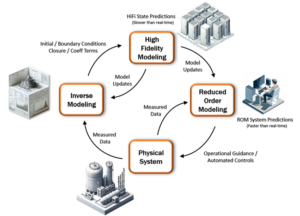In the MSRR, the fuel salt composition will evolve over time due to both salt fission and activation in the reactor region as well as the subsequent decay of radioisotopes. As such, salt physical characteristics such as thermal-fluid properties, voiding fraction, oxidation-reduction potential, and radiotoxicity are expected to changes as well. These changes in salt characteristics are important to various aspects of operation, including salt fuel loading / burnup, reactivity feedbacks, corrosion control, waste management, and maintenance dose rates. Though various measurement techniques might be employed for assessing the salt conditions, radiation detection and spectrum analysis provides a means of assessing a wide variety of salt composition metrics via “remote sensing” (i.e. does not require placing additional instrumentation into the salt loop). The MIT Irradiation loop will serve as a test-bed for an MSRR’s salt radiation monitoring system, helping to determine the type and placement of detectors as well as how to deduce salt conditions from the gathered data.
As part of normal operation, the MSRR is expected to implement an information / analysis pipeline such as illustrated in Figure 1. In this pipeline, system measurement data is fed through various simple Inverse Models (IMs) to deduce limited unobservable salt characteristics which may in turn be fed into High Fidelity (HiFi) models to determine further salt features and predictions concerning salt behavior which might be further used to train faster-than-real-time Reduced Order Models (ROMs) for on-the-fly operational guidance. The primary focus of this effort is the development of this information pipeline for salt assessment through remote sensing of the radiation fields, as well as determining what salt characteristics might be deducible from radiation field analysis, how this would be accomplished practically, and establish these methods through proof-of-principle demonstrations. This work will touch on all aspects of the pipeline, with iterations between the design of the various stages expected, such as simulations informing detector placement and new detector data improving simulation models.

Figure 1: Data / Simulation Pipeline
Task 1: Determine what salt characteristics could be deduced from radiation field analysis, determine how this would be practically accomplished (i.e. detector selection and placement strategies), and prioritize the various options based on viability, cost, and value added.
Task 2: Set up initial high priority detectors, conduct applicable radiation field detection experiments, and collect the data of said experiments for development of simulation models. Establishing access to the experimental data along with post-processing infrastructure will be established as part of this task.
Task 3: Develop HiFi reference models along with requisite post-processing infrastructure will be setup to allow for the generation of synthetic data, which will in turn be used for building the modeling pipelines. This is necessary because actual measurement data will not be available until after experiment completion. These reference models will be different from the HiFi models used as part of the pipelines, and will serve as synthetic data generators, in lieu of actual physical measurements.
Task 4: Modeling pipelines will be setup using data generated from the Task 2 HiFi reference models. This task will explore various pipeline architectures, evaluating and documenting their performance with regards to simulating the salt conditions in terms of runtime, computational cost, and accuracy Figures of Merits (FOMs).
Task 5: Modeling pipelines will be adapted to the real experimental results once they become available, using actual measurement data. After evaluating the performance of the system as whole, detectors, their placement, and modeling pipeline, design iterations will be conducted, repeating Tasks 1 thru 5 to improve overall system performance.
